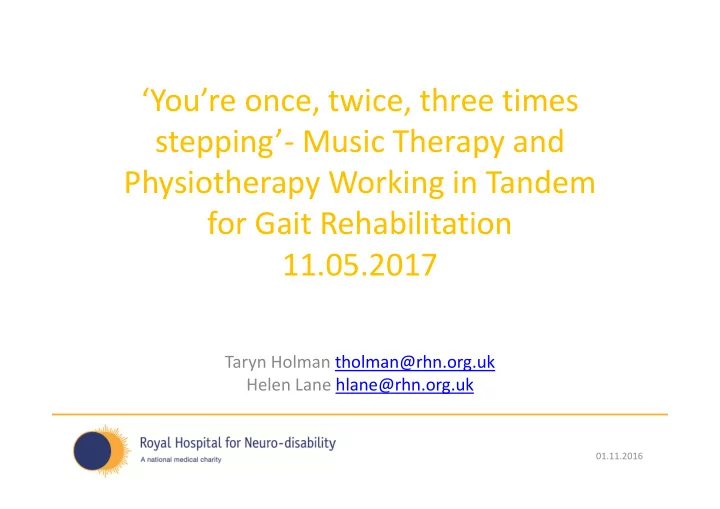

‘You’re once, twice, three times stepping’ ‐ Music Therapy and Physiotherapy Working in Tandem for Gait Rehabilitation 11.05.2017 Taryn Holman tholman@rhn.org.uk Helen Lane hlane@rhn.org.uk 01.11.2016
Background • 51 year old female • Clinical Nurse Specialist • Left MCA stroke May 2016 • Admitted to The Royal Hospital for Neuro ‐ disability August 2016 01.11.2016
Impairments Activity Participation (Body Structure and functioning) Assistance of 1 to Aphasia – mainly Role as a clinical wash and dress expressive nurse specialist Assistance of 2 Dense right and sara steddy to Participation in hemiparesis transfer affecting arm>leg religious activities Vision: Right Independent hemianopia Married ‐ role as a sitting balance wife Cognitive impairments Apraxia 01.11.2016
Referral to Music Therapy • Primary focus upon speech and expression • Melodic Intonation Therapy: – Expressive aphasia – Good comprehension • Rhythmic and melodic shaping • Step wise progression • Functional use of phrase 01.11.2016
Linking Positive Positive response to response in Melodic physical Intonation rehabilitation? Therapy 01.11.2016
Gait Impairments • Lacking symmetry in gait pattern • Formal muscle testing ‐ flickers of activity right lower limb • Reduced stance phase right lower limb • Unable to initiate swing with right lower limb • Reduced step length and cadence 01.11.2016
Neurologic Music Therapy (NMT) • ‘The therapeutic application of music to cognitive, sensory and motor dysfunction due to neurologic disease of the human nervous system’ • Techniques are directed towards functional therapeutic goals (Thaut 1999) Helen Lane ‘Restorative Music Therapy 06/10/2016 Techniques’ 06.10.2016
Neurologic Music Therapy • 19 standardised techniques (NMT) – Sensorimotor – Speech and language – Cognition • Intensive training course 01.11.2016
The Technique • Sensorimotor realm • Patterned Sensory Enhancement (PSE) • External temporal cueing through music 01.11.2016
PSE Elements • Metronome • Meter and melody • Sung cues 01.11.2016
Sessions • Joint sessions with music therapy & physio • Partial body weight support (PBWS) gait training + FES • Aquatic Therapy, motormed bike, plinth based exercises (+/ ‐ FES), treadmill training
Phase 1: Weight transfers Physiotherapy Music Therapy Improving stance stability Improvised 2/4 melody + / ‐ FES glutes Dominant to tonic With and without use of partial Simple and repetitive body weight support Additional gym sessions Sung cues 01.11.2016
Video 1 forward and back.wmv 01.11.2016
Phase 2: Partial bodyweight supported walking Music Therapy Physiotherapy Adapted familiar song Improving stance stability introduced + / ‐ FES glutes Metronome baseline Waltz meter (3/4) March Improving swing phase right leg (2/4) Reduced manual handling for Sung cues therapists Lyrics 01.11.2016
Phase 3: Walking with support of two Music Therapy Physiotherapy Remained challenging Flexible meters Familiar song Various orthoses trialled to support right stance Therapist modelling phase and ankle stability / dorsiflexion 01.11.2016
Outcomes & Reflections • Formal outcomes • With music versus without in sessions • Endurance • Fluidity ‐ swing phase • Patient goal • Strength • Treadmill • Therapist load • Mood and motivation 01.11.2016
Admission Goal Discharge CAG CAG Evaluation 1 Eating 30 Safety Awareness 2 Swallowing 7 29 Concentration 3 Grooming 28 Orientation 4 Bathing 6 27 Memory 5 Dressing Upper Body 5 26 Problem Solving 6 Dressing Lower Body 4 25 Leisure Activities 7 Toileting 3 2 24 Adjustment to Limitations 8.1 Bladder ‐ Level of assistance 1 23 Emotional Status 8.2 Bladder ‐ Frequency of accidents 0 22 Social Interaction 9.1 Bowel ‐ Level of assistance 21 Speech Intelligibility 9.2 Bowel ‐ Frequency of accidents 20 Writing 10 Bed, Chair, Wheelchair transfer 19 Reading 11 Toilet transfer 18 Expression 12 Tub, Shower transfer 17 Comprehension 13 Car transfer 16.1 Community Mobility 14.1 Locomotion ‐ Walking "w" 15 Stairs 14.2 Locomotion ‐ Wheelchair "c" 01.11.2016
Outcomes & Reflections • Formal outcomes • With music versus without in sessions • Endurance • Fluidity ‐ swing phase • Patient goal • Strength • Treadmill • Therapist load • Mood and motivation 01.11.2016
References PSE / Neurologic Music Therapy • Thaut, M (1999) Training Manual for Neurologic Music Therapy Training Institute • Bukowska et al. Neurologic Music Therapy Training for Mobility and Stability Rehabilitation with Parkinson’s Disease – A Pilot Study . Front Hum Neurosci. 2015; 9: 710. • Yoon ‐ Kyum Shin et al. Effect of Rhythmic Auditory Stimulation on Hemiplegic Gait Patterns. Yonsei Medical Journal. 2015; 56 (6): 1703 ‐ 1713 Partial Body Weight Support 01.11.2016
Recommend
More recommend